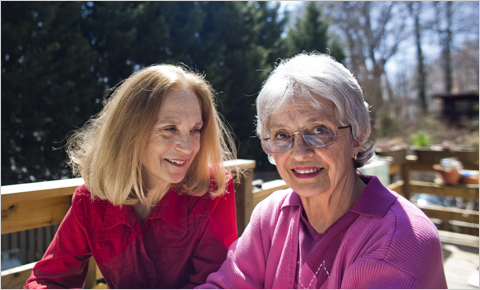|
Coordination: Too Expensive for Medicare?
By
Anne Underwood,
The New York Times
March 31, 2009

James Lo Scalzo for The New York Times Cecilia Daub, left, and Joanne
Philleo.
A
former two-pack-a-day smoker, Jude Cashman of Bethesda, Md., suffered chronic bronchitis and pneumonia for the last several years of his life. Repeated hospitalizations were traumatic and frightening. But help came to Mr. Cashman and his wife, Joanne Philleo, in the person of Cecilia Daub, a registered nurse with a program called Guided Care.
Ms. Daub accompanied Mr. Cashman to doctor’s visits. Between appointments, she was available by phone to answer his questions about symptoms and treatment. She even came to the house and coaxed him into doing lung exercises to clear his airways — exercises that he tended to shirk if Ms. Daub wasn’t there.
Perhaps best of all, when he was hospitalized, Ms. Daub would come to the ward to make sure staffers knew what medications he was taking, what allergies he had, and the names and numbers of his various doctors. “She would comfort us and explain what was going on,” said Ms.
Philleo.
What Ms. Daub did for Mr. Cashman amounts to a radical departure from what usually happens to patients lost in the maze of U.S. health care. I remember the helpless feeling I had during my own mother’s final hospitalizations a year ago. It seemed as if I was at the wheel of a car that I wasn’t licensed to drive.
Should I authorize more invasive care? Should I agree to additional tests and procedures that might help or hurt? Should I put her on hospice care rather than make her suffer any longer? I made the best decisions I could, but to this day, wonder if I made the right choices. I would have loved a program like Guided Care.
Judging by a three-year trial of Guided Care in the Baltimore-Washington area, so would many others. Results showed that patients rated the quality of their health care higher, physicians reported increased satisfaction, and caregivers registered lower stress levels on a measurement called the C.S.I. — the Caregiver Strain Index. Overall health care costs even came down by $75,000 per nurse in the first year, or $1,300 per patient. (Data from the second and third years have not been analyzed yet.)
Such “care coordination” programs have garnered intense interest in recent years. But as a recent study in the Journal of the American Medical Association showed, they’re harder to implement than you might expect. Of 15 programs included in the study, only one reduced hospitalizations (though two others also positively affected patient health). And none brought down expenditures. “The best was cost neutral,” said Randall Brown, director of health research at Mathematica Policy Research, Inc., in Princeton, and senior author of the paper.
That’s too bad, because Medicare is desperately seeking ways to reduce costs. And the proposed solutions are not going to make anyone happy — increase payroll taxes, make retirees shoulder more of the burden, reduce benefits, or cut payments to doctors and hospitals.
If care coordination could help patients and reduce costs, too, these programs would be more widely implemented. “We can’t spend $200 a month to save $190,” says Mr. Brown. “What Medicare is looking for and needs is ways to generate net savings.”
The JAMA study highlighted features of the most effective programs, characteristics that caregivers should seek out
when enrolling family members. Among the lessons:
* Care coordinators need to interact in person with patients and not simply deal with them by telephone.
* They must collaborate closely with the patients’ physicians.
* Services are particularly important during transitions, when patients are entering and leaving the hospital.
* And when it comes to cost savings, the benefits are greatest when services are directed to patients with the most complex problems.
All four are features of Guided Care. But its $1,300 savings per patient are hardly enough to rescue Medicare. If a program like this were simply to break even, though, many caregivers would consider it well worth continuing.
Ms. Philleo, for example, has no doubt that her husband received better care as a result and possibly dodged further infections and hospitalizations. “I call Cecilia my miracle worker,” she said.
Jude Cashman passed away in January at the age of 79. Now Ms. Philleo is struggling with her own health problems. In addition to mourning her husband, she’s feeling adrift because she herself is not part of Guided Care. Being without the assistance of Ms. Daub, she said, “is like another loss.”
More Information on US Elder Rights Issues
Copyright © Global Action on Aging
Terms of Use |
Privacy Policy | Contact
Us
|



